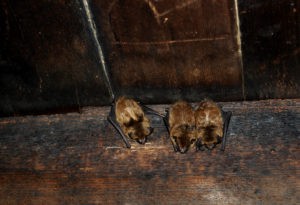If you suspect something is in the attic, here is the 411 about bats. Clearly we’re not worried about storing baseball gear in the attic, but rather the flying mammalian type. Let’s explore everything from why they’re there to what threat they bring.
What is a bat?
Bats fly like birds, but they are actually mammals. The insectivore bats devour loads of insects. A little brown bat can munch down over 500 small insects (like pesky mosquitoes) in just an hour! Frugivore bats eat pollens, seeds and even fruit. Vampire bats consume blood and other bats eat birds, reptiles, etc.
Why do bats like attics?

The first reason bats like attics is they are quiet places to sleep out of the sunlight during the day. Typically, bats hide out in trees or caves. The attic inside of a home just happens to contain many of the same features: shade, seclusion, protection, and a place to roost. Especially when raising a young brood, better protection is more desirable.
The second reason bats like attics is they are a great place to hibernate. Bats are incredibly high-energy creatures. When cold temperatures hit, they are forced to either migrate or hibernate. In hibernation mode, a bat’s heart rate will drop from a few hundred beats per minute to as low as 10. They also have another mode call torpor where other bodily functions slow down to save energy. Torpor reduces energy costs to about 2%, If they are in a warmer area such as an attic, energy conservation is simplified and less stressful.
Will they hurt structures?
Bats are opportunistic creatures. They don’t chew or claw their way into an attic or wall void, but they are very efficient at finding small entry points that seem too small for their size. Once inside, it is the urine and guano (bat droppings) that will cause damage to the structure through moisture issues or contamination. The odor and stains can be difficult to remove.
Are bats dangerous?
Generally speaking, bats are very beneficial creatures as natural pest controllers. Most of the fear surrounding bats is related to the rabies virus. Of bats captured and tested, only about 6% carry the virus and this represents an incredibly small portion of the entire population. The kicker is that roughly 90% of human rabies cases come from contact with bats. To keep this in perspective, these rabies cases are typically 1-2 per year in the USA.
Bats are also known for the respiratory disease called Histoplasmosis. Bats don’t directly cause this, but their droppings are a rich breeding ground for the fungus Histplamsa Capsulatum. This fungus thrives in guano and causes Histoplasmosis.
Bats also are known for introducing ectoparasites such as bat mites, bat bugs, bat ticks, etc. These pests are host specific, so typically solving the bat issue removes the secondary pests.
The rich lore around vampires may have some origin ties to bats, but vampire bats typically feed on livestock which are easily accessible. In addition to humans being less than ideal targets, vampire bats are mostly located in the tropics between Mexico and South America.
What to do about bats…
If you are in a known bat migration area, a simple solution is to install bat houses. Bat houses give bats a nice place to roost as they pass through or hang around for extended periods. If they have a nice house at their disposal, they are more likely to leave yours alone. The perk of the bat house approach is the bats can eat large amounts of unwanted insects in the area.
If bats are already in the home, exclusionary devices such as one-way exits (the bats can leave but not come back in) are the way to go. Keep in mind bats inside are most likely females. Females form colonies to have a place to have their babies. Before starting the exit process, it is best to identify which bat you are dealing with so you can avoid interrupting the maternity season. The little & big brown bat’s seasons are June through mid-August, the Mexican free tail bat is late May through early August, and the evening bat is late April through mid July. By avoiding these dates, you can ensure bat broods are not left behind.
Unsure what is up there?
Having a professional opinion helps get your started on the right track and provides peace of mind. Reach out to our experts at Rove Pest Control to find out the best way to proceed.